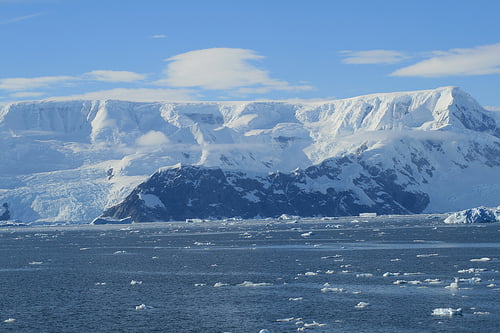

Environment
Channels below the surface found to mask Antarctic ice retreat
Scientists at Durham University have discovered that Antarctic ice sheet retreat can briefly stop during extended phases of global warming, making it appear like glaciers are not decreasing at all.
The team found that the make-up and movement of below-ice channels hold significant influence on the activities of much of the ice. This action, it says, can hide signs of ice sheet retreat.
The results of the new research led by Durham University in collaboration with the University of Sheffield, the University of Cambridge, and the British Antarctic Survey were published this week in the journal Nature Geoscience. The Natural Environment Research Council financially supported the research.
The publication comes just a couple of months after a study found that large volumes of methane could be locked beneath ice-covered regions of Antarctica, and could be released into the atmosphere as the ice retreats.
According to the report, the findings provide the first simulation of past ice sheet retreat and collapse over a 10,000 year period in Antarctica, and shed new light on what makes ice stable or unstable and will consequently help refine predictions of future ice behaviour and global sea level rise.
“Our research shows that the physical shape of the channels is a more important factor in controlling ice stability than was previously realised”, explained Dr Stewart Jamieson, a glaciologist at the department of geography at Durham University, and lead author of the report.
“Channel width can have a major effect on ice flow, and determines how fast retreat, and therefore sea level rise, can happen.”
The Intergovernmental Panel on Climate Change (IPCC) has highlighted the difficulty in predicting future sea level rise, with the aim to analyse the interactions between evolving ice sheets, oceans, sea level and climate. Significant efforts have been made over the last decade to develop computer models and collect data in order to reduce uncertainties and understand the potential impacts under scenarios of future climate change.
Although climatic and oceanic changes are crucial drivers of ice loss, the recently published research shows that the landscape below the ice has a significant impact on the speed of any retreat.
“Our results suggest that, during an overall phase of retreat, an ice stream can appear almost stable when in fact, in the longer-term, the opposite may be the case”, continued Jamieson.
“Getting a clearer picture of the landscape beneath the ice is crucial if future predictions of change in the ice sheets and sea level are to be improved.”
Marine-based ice streams are the fast flowing arteries of ice sheets, draining roughly 90% of the ice that reaches the sea. Flowing through large channels, the ice can move thousands of metres in a single year.
According to the scientists, the unpredictable nature of ice streams makes forecasting ice sheet retreat extremely difficult. Accelerating ice streams can even cause a rise in sea levels.
“Ice streams are like taps filling a bath, but the problem here is that we do not know if something is suddenly going to turn them up or even turn them off”, explained Dr Chris Stokes, co-author of the report.
Over the last 20 years, Satellite imagery has aided our knowledge of ice sheet stability, revealing that many ice streams are getting thinner and retreating due to oceanic and climatic warming. The new research shows that ice behaviour can be successfully simulated in areas where ice streams meet the sea.
The researchers looked at the landscape of the seafloor in Marguerite Bay, located in the Antarctic Peninsula, and discovered that, during a rapid phase of recession 13,000 years ago, retreat paused many times.
Using a specially designed computer model, they found the same pattern could be reproduced in a series of simulations. These simulations showed that the ice dragged on the sides of the channel more where it was narrow was causing retreat to slow, and, in places, temporarily stop for decades to centuries before retreat continued.
Many ice streams are found in channels with beds that are below sea level and that deepen inland. Current theory suggests that ice loss can increase rapidly in deeper water, but the new findings show that channel width plays a crucial role also, and that narrow bottlenecks in the landscape beneath the ice can cause retreat to slow down.
“We can see from our simulations and from new maps of the ocean floor that these bottlenecks occur in the same place as pauses or slowdowns in past ice retreat”, described Dr Andreas Vieli, a member of the geography department at Durham University.
“This means we should look more closely at the shape of the bed underneath Greenland and Antarctica to better understand how ice might retreat in the future.”
Dr Claus-Dieter Hillenbrand, from the British Antarctic Survey, which is currently under threat of closure, added to this viewpoint, saying, “Knowledge of the factors influencing stability and retreat of ice streams is of particular concern because significant portions of the West Antarctic and Greenland ice sheets are currently losing mass that contributes significantly to sea level rise.
“Our model results help to explain the apparently time-transgressive retreat of ice streams around Antarctica following the last ice age.”
The researchers conclude that understanding ice stream behaviour, as well as the rate of mass loss from ice sheets and glaciers, is essential to future forecasts and calculations of global warming.
Further reading:
Government attacked on proposed cuts to British Antarctic Survey
To tackle the melting Arctic is to tackle climate change itself
MPs publish report urging Arctic oil drilling halt


 Environment10 months ago
Environment10 months agoAre Polymer Banknotes: an Eco-Friendly Trend or a Groundswell?

 Environment11 months ago
Environment11 months agoEco-Friendly Home Improvements: Top 7 Upgrades for 2025

 Features9 months ago
Features9 months agoEco-Friendly Cryptocurrencies: Sustainable Investment Choices

 Features10 months ago
Features10 months agoEco-Friendly Crypto Traders Must Find the Right Exchange




























